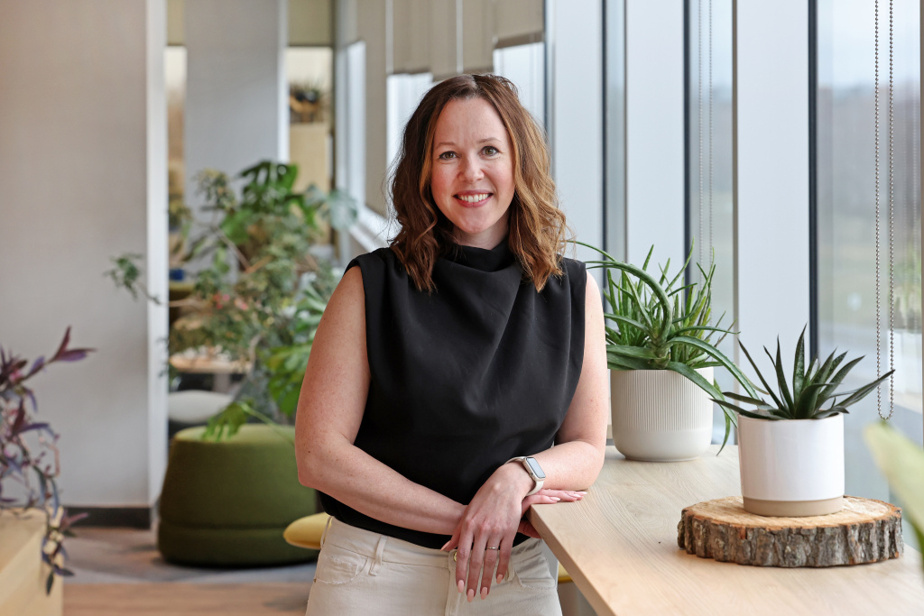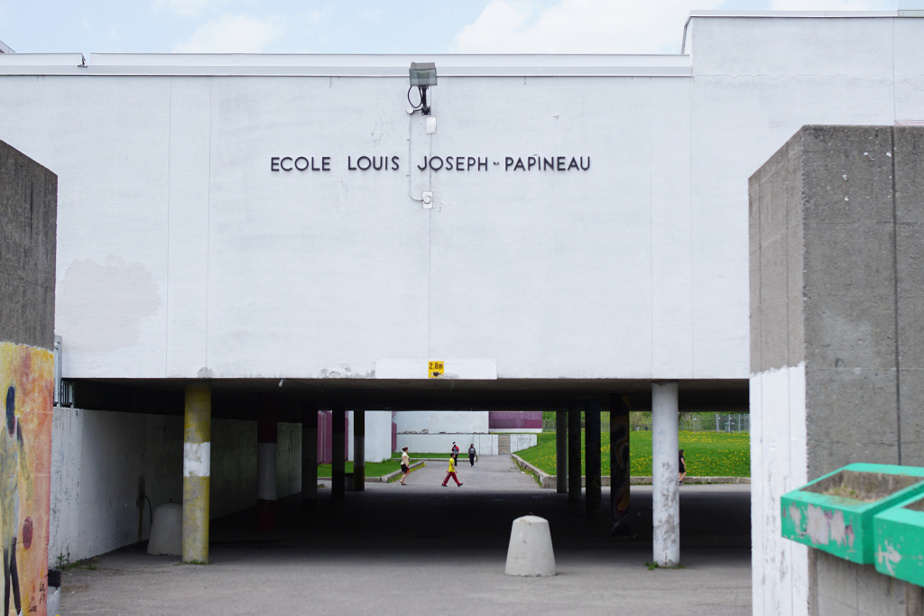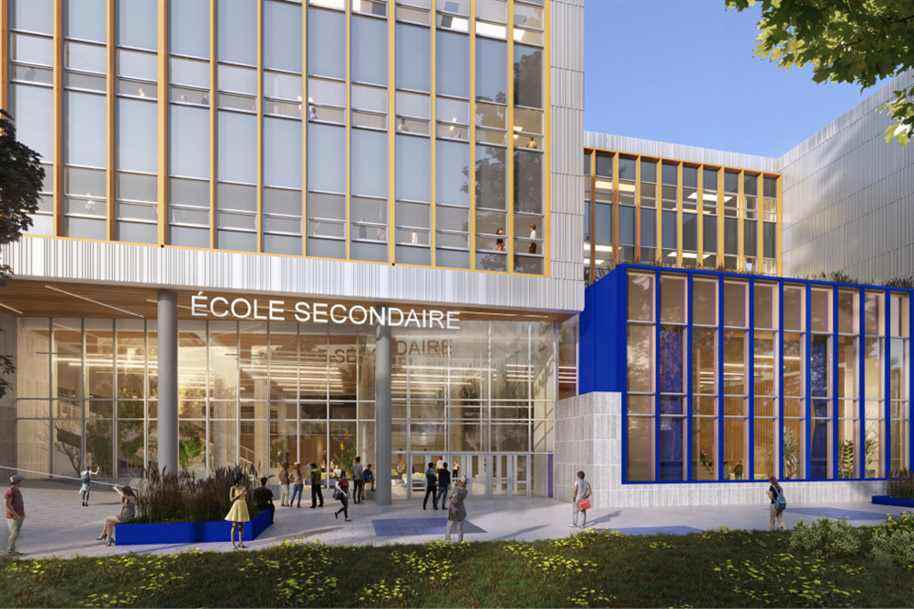Posted at 5:00 a.m.
In all the projects for new secondary schools, this is clearly specified. There will be “natural light”, windows through which the students will see the sun, the rain, the snow. A simple glance at the secondary schools under construction is enough to guess that the watchword is above all not to look like the general purpose schools built in the 1970s.
The idea, says Martin Duquette, assistant director general at the Pointe-de-l’Île school service centre, “is that the schools don’t look like big shopping centres, but they facilitate the family spirit”.
A big family, of course: the future schools of Montreal-North and Anjou, whose opening is planned by 2024, will be able to accommodate 1,700 and 1,800 students respectively. That of Laval is planned for 2000 students. We stay in big numbers.

PHOTO PHILIPPE BOIVIN, THE PRESS
Laval’s new public secondary school is currently under construction.
That 13 schools are under construction is exceptional, notes Nicolas Prévost, president of the Quebec Federation of Educational Establishment Directors (FQDE).
You have to give that to the CAQ: they have made big investments in education.
Nicolas Prévost, President of the FQDE
This contrasts with previous governments, which themselves invested very little in schools, accumulated a very large maintenance deficit, with what this led to as decrepitude, he underlines.
This is what the Auditor General wrote in 2019: the amounts granted by the government to maintain school buildings “have almost always been less than 2% of their replacement value, even though this is a threshold recommended minimum to keep them in good condition.
For a lifetime of at least 75 years
Who ensures that the new schools will be inviting, functional and sustainable? The Legault government has entrusted the drafting of the reference guide – which is 1,500 pages – to two architectural firms, Prisme and Lemay-Leclerc, themselves responsible for four school construction sites in progress (Laval, Chambly, Mirabel and LaSalle , to Montreal).

PHOTO DAVID BOILY, THE PRESS
The construction site of the new LaSalle school in Montreal
“The design aims for a minimum life cycle of 75 years,” says Krystel Flamand, lead architect at Prisme and project director of Consortium Lemay | Leclerc | Leclerc (Prism).
In the 1970s, she observes, the polyvalentes were built “on the edge of the prison model”, very inward-looking. It’s because in one district, the arrival of a thousand teenagers was not viewed with a very good eye.
And no, it was not to save on heating that so many multi-purposes (especially in Montreal and its more or less immediate suburbs) were built without windows. “We actually wanted to avoid the students being distracted by what was happening outside,” explains Ms.me Flemish.
Today, it is quite the opposite. We want windows, lots of windows, wood too, and we want to get away from the maze-like multipurpose.

PHOTO ROBERT SKINNER, THE PRESS
Krystel Flamand, architect and project director of Consortium Lemay | Leclerc | Leclerc (Prism)
We build schools that have a real heart, with places of socialization conducive to the feeling of belonging, with a clear entrance, too.
Krystel Flamand, architect and project director of Consortium Lemay | Leclerc | Leclerc (Prism)
Another priority: to place the school “in the heart of the district”. In the borough of LaSalle, this will be even more true than elsewhere. The new high school is built a stone’s throw from an elementary school, Cégep André-Laurendeau, the Aquadôme aquatic center and the Théâtre Desjardins. The facilities of some will be able to benefit others, the future school arriving with a large soccer field.
Ana Rebeca de Leon, 16, admits that she would have dreamed of finding herself in beautiful walls. Her family life has meant that she is in her third (old) high school. She has a particularly bad memory of one of them, in the suburbs of Montreal, “where lessons were given in the basement, without windows. It’s demotivating.”
No doubt other factors are at play, but she feels that the crowds of students, the noise and the absence of light contribute “to the fact that at midday everyone has looking tired”.
Claudine St-Georges, who was a special education technician for 35 years at the Montreal high school Antoine-de-Saint-Exupéry, until her retirement in 2020, remembers the daily life at school, before some of the young people can be sent to an adjacent building. “There were so many people in the corridors that we had seriously considered installing traffic arrows. So many people, it was so noisy! »
The architect Krystel Flamand assures that in the plans for new secondary schools, “clear parameters to be achieved in order to limit noise have been drawn up”.
The image of public schools needs to be restored
Mélanie Hubert, president of the Syndicat de l’enseignement de l’Ouest de Montréal, is delighted with the construction of a new secondary school in LaSalle.
Independently of the quality of the education offered, “beautiful premises contribute to the image of a school. When it looks modern, bright, it tints the parents’ perception and it can help to enhance the perception of the public school”. Even if, in his opinion, the retention of young people in the face of the exodus to the private sector cannot only pass through architecture. What the research says, says Roch Chouinard, professor emeritus in the Faculty of Education at the University of Montreal, is that the aesthetics of a school and its size contribute to happiness at school and motivation, without being the main factor. After all, Chouinard points out, when someone is asked about their memories of high school, “they’ll talk a lot more about being a failure and having no friends than about the lack of windows.” .
Yes, it counts, but most importantly, he says, “it’s a school where a student feels good, where he feels independent, in touch with others, with good self-esteem and with whom he has a sense of belonging”.
How much will the new secondary schools cost?
In the office of Jean-François Roberge, Minister of Education, it is indicated that the costs amount to 2.7 billion, or 100 million more than the total of the calls for tenders dating from 2020. In 2019, Jean-François Roberge had signaled that the construction of new schools would be done in “unprecedented” time frames. In fact, the update of the guide to the criteria for the construction of secondary schools had not yet been done (unlike the guide for primary schools which had already been drawn up). The figure of 1.1 billion already given in the media for the construction of the new secondary schools was in fact the only reflection of an estimate of what these schools would have cost if the plans had been based on the old standards, that of 2009, says Florent Tanlet, Mr. Roberge’s press attaché.
The new schools
- Charlesbourg (Quebec), 2024
- Anjou (Montreal), 2024
- Montreal North/Saint-Léonard (Montreal), 2024
- Drummondville, 2024
- Chateauguay, 2024
- Saint-Zotique (near Salaberry-de-Valleyfield), 2023
- Vaudreuil-Dorion, 2023
- St. Jerome, 2023
- Terrebonne, 2023
- Chisasibi, 2023
- Laval, 2023
- LaSalle (Montreal), 2023
- Mirabel, 2023
- (Expansion of Chambly secondary school: 2023)
Building without forgetting to renovate

PHOTO MARTIN CHAMBERLAND, ARCHIVES LA PRESSE
Louis-Joseph-Papineau School, in Montreal
“For young people who live in poverty at home, it’s important to be able to say to themselves: ‘Wow, at least we have a good school,'” notes Frantz Benjamin, Liberal MP for Viau, which includes the Saint -Michel, in Montreal.
This time, the new school will be built in the riding next door, in Montreal North. He can only be delighted that this neighborhood – one of the poorest in Canada – is getting a brand new establishment.
But at the same time, he also has a twinge in his heart at the thought that his young people, in Saint-Michel, remain within the old walls of their high schools. The same ones who already welcomed them, his brother and him, more than 30 years ago.
The MP remembers his haste for the bell to ring “so he could go to the park and see the sun”.
Mr. Benjamin is particularly saddened for the young people of the Sainte-Lucie primary school, who, in recent years, have been relocated to the Louis-Joseph-Papineau high school because their school was falling into disrepair. Children will have known only Louis-Joseph-Papineau, by doing almost all of their primary and secondary school there. “Ten years of their life…”, he drops.
Private sector competition
Mr. Benjamin also participated in the long crusade to provide Louis-Joseph-Papineau with windows (which are still not installed).

PHOTO DOMINICK GRAVEL, THE PRESS
Frantz Benjamin, Liberal MP for Viau
I know parents who bleed themselves white to send their children to a school other than high school.
Frantz Benjamin, Liberal MP for Viau
He is convinced that brand new public secondary schools can help fight against dropping out and improve academic success.
The fact remains that a secondary school is much more expensive than a primary school, and all of them cannot be built at the same time. Frantz Benjamin knows this well, but “out of social justice”, he pleads that at the very least, improvements be made to the old schools in which the vast majority of young people are kept.
In this regard, he mentions the concert hall that Joseph-François-Perrault has been asking for for years (still in Saint-Michel), where the music program enjoys an excellent reputation. If it were built, it could be accessible to residents of Saint-Michel, a neighborhood that really lacks cultural infrastructure.
Average age: 50 years old
In 2019, the Auditor General noted that time is running out. All levels combined, the schools are on average 50 years old. “The more time passes, the more the condition of the buildings deteriorates and the more we risk having to rebuild them instead of repairing them. »
One of the schools under construction, that of Châteauguay, actually succeeds the demolition of the existing school.
But apart from this exception, the polyvalentes of the 1970s will continue to be frequented, however criticized they may be. And from a strict architectural point of view, they have value in that they are representative of their time, underlines Claudine Déom, professor at the School of Architecture of the University of Montreal since 2006.
But we can very well adapt them to today’s needs. She cites the example of the old HEC Montréal building, which was in the style of old high schools, and in which windows were drilled into the large concrete facades.

